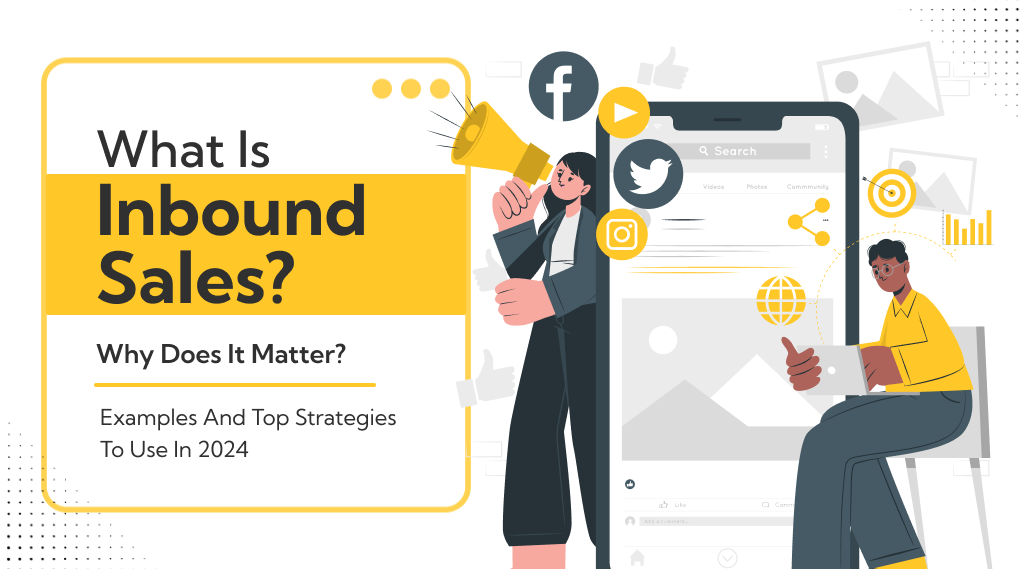Introduction
In the ever-evolving world of sales and marketing, staying ahead of the curve is essential to success. Inbound sales is a methodology that has gained significant traction in recent years, and as we look ahead to 2024, understanding this approach and its strategies is crucial.
In this article, we will delve into the meaning of inbound sales, explore the inbound sales model, and differentiate it from outbound sales. Additionally, we will provide examples and top strategies to help you harness the power of inbound sales in 2024 and beyond.
Inbound Sales Meaning
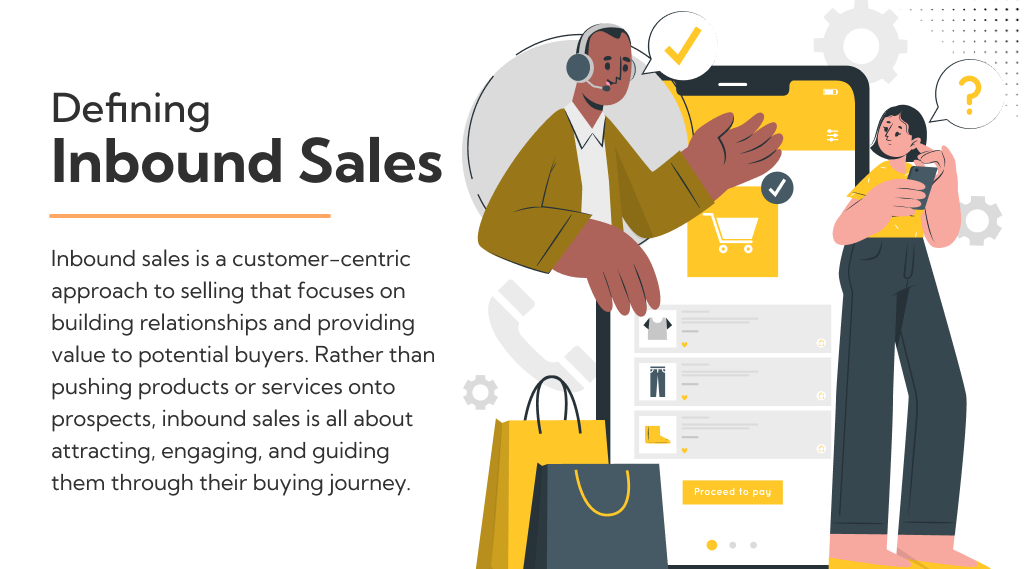
Inbound sales is a customer-centric approach to selling that focuses on building relationships and providing value to potential buyers. Rather than pushing products or services onto prospects, inbound sales is all about attracting, engaging, and guiding them through their buying journey.
This methodology emphasizes creating a seamless and helpful experience for customers, which can ultimately lead to higher conversion rates and customer satisfaction.
What Is an Inbound Sales Model?
The inbound sales model revolves around the idea that buyers should come to you, rather than you chasing them. Here’s a simplified breakdown of the inbound sales model:
1. Attract: This is the first step in the inbound sales process. It involves creating valuable content and resources that target your ideal customers. This content can take various forms, such as blog posts, videos, social media posts, and more. By offering information and solutions that address their pain points, you can attract potential buyers to your brand.
2. Engage: Once you’ve captured the attention of potential customers, the next step is to engage with them. This could involve personalized email marketing, chatbots, or live chat support. The goal is to keep the conversation going and provide the information or assistance they need.
3. Delight: Inbound sales doesn’t stop once a sale is made. It extends beyond the initial purchase to delight customers. Providing exceptional post-purchase support and experiences can turn satisfied customers into promoters who refer your brand to others.
Inbound Sales vs Outbound Sales: What’s the Difference?
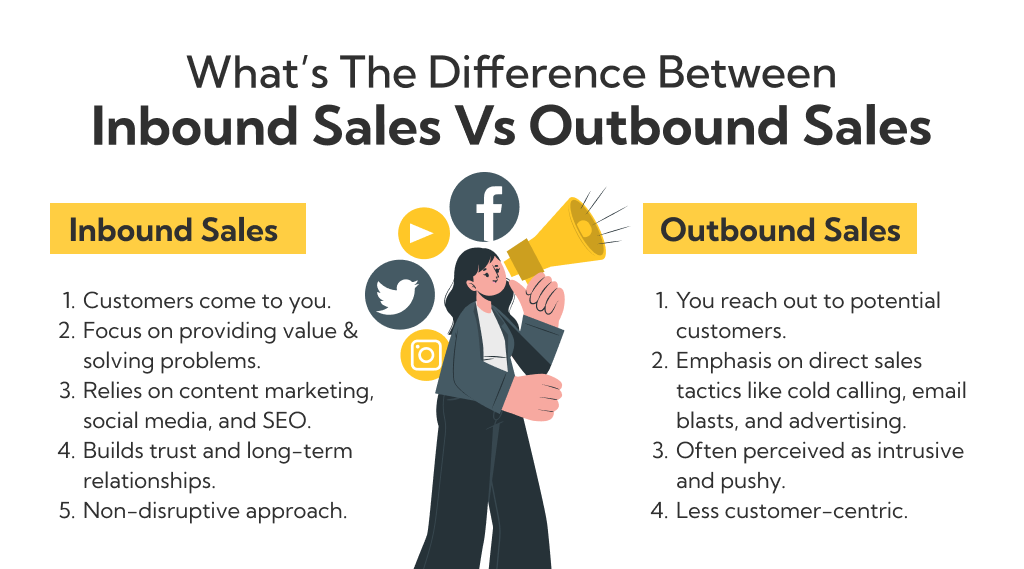
To understand inbound sales fully, it’s essential to differentiate it from outbound sales, the traditional approach to sales. Here’s how they differ:
Inbound Sales:
- Customers come to you.
- Focus on providing value and solving problems.
- Relies on content marketing, social media, and SEO.
- Builds trust and long-term relationships.
- Non-disruptive approach.
Outbound Sales:
- You reach out to potential customers.
- Emphasis on direct sales tactics like cold calling, email blasts, and advertising.
- Often perceived as intrusive and pushy.
- Less customer-centric.
Examples of Inbound Sales Strategies for 2024
1. Content Marketing: Continue to create high-quality, informative, and relevant content that addresses your target audience’s needs. This could be in the form of blog posts, videos, podcasts, and interactive content like quizzes and webinars.
2. Personalization: Use data and AI-driven tools to personalize your communication and recommendations. Tailoring your approach to individual customer preferences can significantly enhance the customer experience.
3. Social Selling: Leverage social media platforms to engage with potential customers, answer their questions, and provide value. Building relationships on platforms like LinkedIn can be especially effective.
4. Chatbots and AI Assistants: Implement chatbots and AI-driven assistants on your website to offer real-time assistance and capture leads. These tools can provide immediate responses and guide visitors through the sales process.
5. Email Marketing Automation: Create automated email sequences that nurture leads and guide them through the sales funnel. Use data analytics to refine your email content and timing.
What Is an Inbound Sales Funnel?
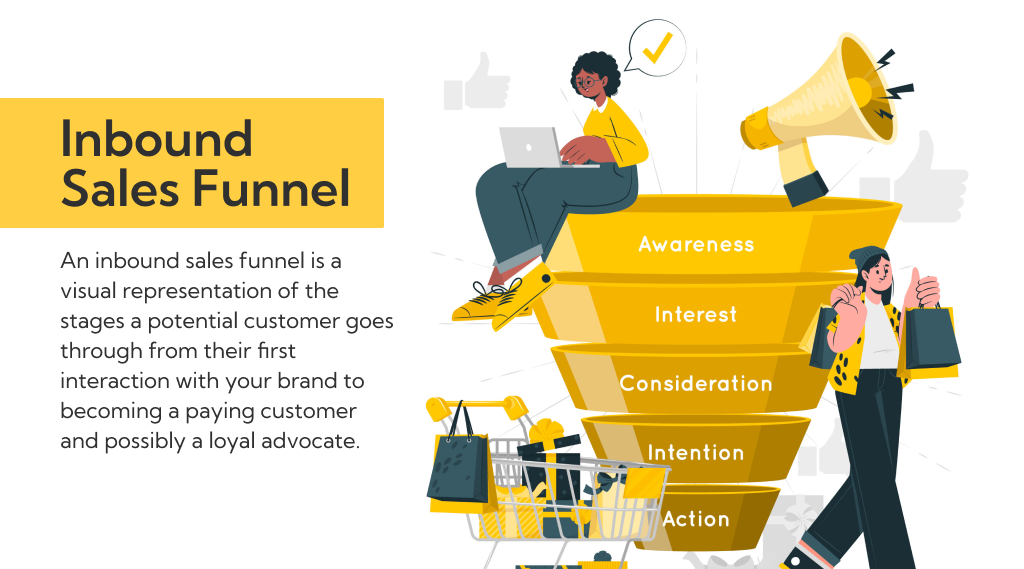
An inbound sales funnel is a visual representation of the stages a potential customer goes through from their first interaction with your brand to becoming a paying customer and possibly a loyal advocate. The primary stages in an inbound sales funnel typically include:
1. Awareness: This is the top of the funnel, where you attract potential leads through various marketing channels like content marketing, social media, SEO, and advertising.
2. Consideration: In this stage, leads start evaluating your products or services. They may engage with more specific content, compare options, and seek answers to their questions.
3. Decision: At the bottom of the funnel, leads are ready to make a decision. They’re comparing your offerings to competitors, looking for incentives to purchase, and seeking that final nudge.
4. Conversion: This is the point where a lead becomes a customer by making a purchase, signing up for a service, or taking another desired action.
5. Delight: After conversion, your goal is to turn customers into promoters. Delighting customers with exceptional support and experiences can lead to word-of-mouth recommendations and repeat business.
How To Create a Perfect Inbound Sales Strategy?
1. Know Your Audience: Start by understanding your target audience’s needs, pain points, and preferences. Create detailed buyer personas to guide your strategy.
2. Content Marketing: Develop high-quality, educational, and engaging content that addresses your audience’s concerns and provides value. This content can take the form of blog posts, videos, webinars, ebooks, and more.
3. SEO and Keyword Strategy: Optimize your content for search engines by conducting thorough keyword research. This will help your content rank higher in search results and attract organic traffic.
4. Lead Nurturing: Implement email marketing campaigns, marketing automation, and personalized content to nurture leads at each stage of the funnel.
5. Social Media Engagement: Actively engage with your audience on social media platforms, responding to comments, sharing relevant content, and participating in conversations.
6. Sales Enablement: Equip your sales team with the tools and resources they need to close deals effectively, such as CRM systems, lead scoring, and sales training.
7. Customer Relationship Management (CRM): Use a CRM system to track and manage customer interactions, helping you build stronger relationships and personalize your approach.
8. Analyze and Adjust: Continuously analyze your strategy’s performance using data and metrics. Make adjustments based on insights to improve your results.
How To Approach Your Inbound Sales Goals & KPIs?
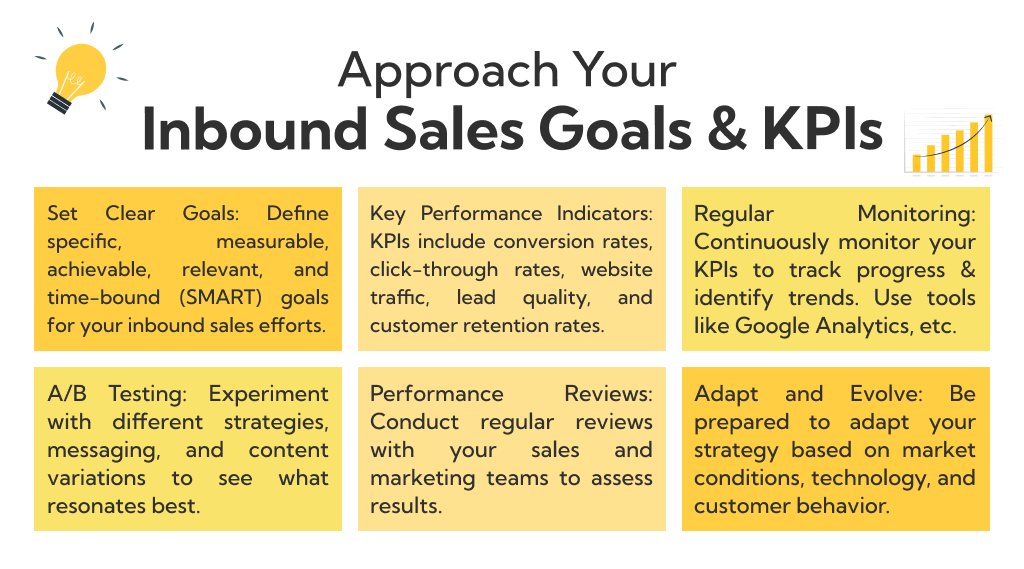
1. Set Clear Goals: Define specific, measurable, achievable, relevant, and time-bound (SMART) goals for your inbound sales efforts. Examples include increasing lead conversion rates, boosting website traffic, or raising customer satisfaction scores.
2. Key Performance Indicators (KPIs): Identify the KPIs that align with your goals. Common inbound sales KPIs include conversion rates, click-through rates, website traffic, lead quality, and customer retention rates.
3. Regular Monitoring: Continuously monitor your KPIs to track progress and identify trends. Use tools like Google Analytics, CRM software, and marketing automation platforms to gather and analyze data.
4. A/B Testing: Experiment with different strategies, messaging, and content variations to see what resonates best with your audience. A/B testing can help optimize your campaigns.
5. Performance Reviews: Conduct regular reviews with your sales and marketing teams to assess results and make data-driven adjustments to your inbound sales strategy.
6. Adapt and Evolve: Be prepared to adapt your strategy based on changing market conditions, technology, and customer behavior.
By creating a well-defined inbound sales funnel, implementing an effective strategy, and monitoring your goals and KPIs, you can build a strong foundation for your sales and marketing efforts, ultimately driving growth and success in your business.
How To Maintain a Good Inbound Sales Pipeline:
Maintaining a healthy inbound sales pipeline is crucial for consistent revenue growth and customer acquisition. Here are some tips to keep your inbound sales pipeline in top shape:
1. Continuous Lead Generation:
Ensure a steady flow of leads into your pipeline by implementing various lead generation strategies. Content marketing, social media engagement, and SEO optimization are effective ways to attract potential customers to the top of your funnel.
2. Lead Nurturing:
Focus on nurturing leads throughout their journey. Provide valuable content and personalized interactions to guide them through the various stages of the funnel. Use marketing automation to send targeted emails, offer relevant resources, and engage prospects effectively.
3. Effective Sales Qualification:
Not all leads are equal. Implement lead scoring to prioritize leads that are most likely to convert. This helps your sales team focus their efforts on the leads with the highest potential, increasing conversion rates and efficiency.
4. Align Sales and Marketing Teams:
Close collaboration between your sales and marketing teams is vital. Ensure both teams are working towards common goals, and maintain open communication. Regular meetings and feedback loops can help in this regard.
5. Use CRM Software:
Implement a robust Customer Relationship Management (CRM) system to manage and track your leads and customers. A CRM helps you keep all relevant data in one place, streamlining your sales processes and allowing for more personalized interactions.
6. Data-Driven Decision Making:
Analyze data and metrics to identify areas for improvement. Regularly review your pipeline metrics, conversion rates, and sales team performance. Make data-driven adjustments to your strategies and tactics.
7. Sales Training and Development:
Invest in ongoing sales training for your team. Equip them with the skills and knowledge they need to engage effectively with prospects and close deals.
5 Inbound Sales Strategies to Try in 2024
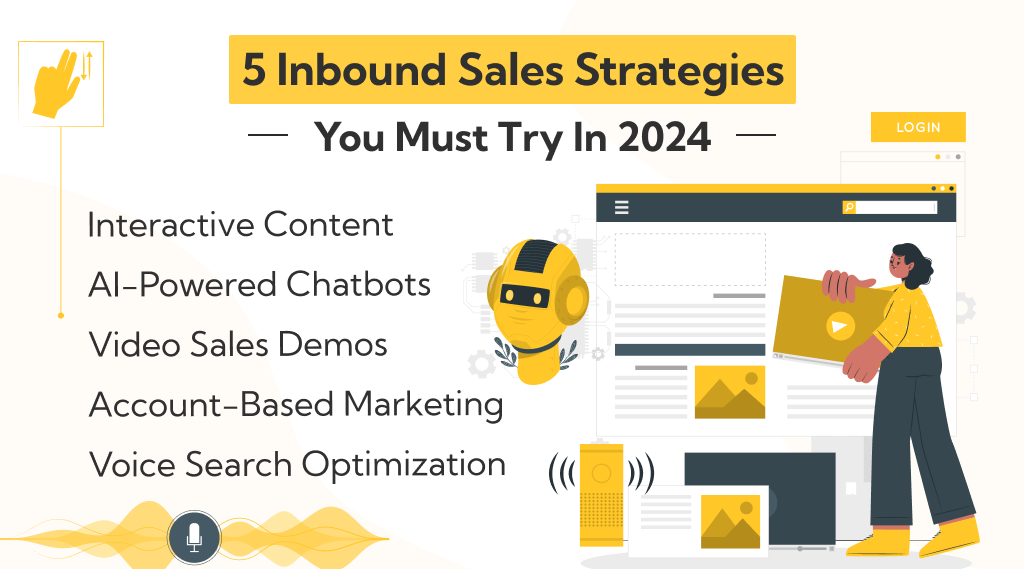
1. Interactive Content: Create interactive content such as quizzes, assessments, and surveys to engage your audience. Interactive content not only captures attention but also provides valuable insights about your leads.
2. AI-Powered Chatbots: Enhance customer support and engagement with AI-powered chatbots. These can assist website visitors, answer common questions, and qualify leads in real time.
3. Video Sales Demos: In 2024, video remains a powerful tool. Use personalized video demonstrations to showcase your products or services to potential customers. Videos are engaging and can convey complex information effectively.
4. Account-Based Marketing (ABM): Implement an account-based marketing strategy to target high-value accounts with personalized, highly tailored content and interactions. ABM can significantly increase conversion rates for strategic accounts.
5. Voice Search Optimization: With the growing prevalence of voice-activated devices, optimizing your content for voice search is a smart move. Focus on answering natural language queries and providing concise, voice-friendly responses.
By combining these innovative inbound sales strategies with effective pipeline maintenance, you can adapt to the changing business landscape in 2024 and achieve sustainable growth in your sales efforts.
10 Inbound Sales Examples To Get Inspired From:
1. HubSpot’s Content Marketing: HubSpot is a pioneer in inbound marketing and sales. They consistently provide valuable content, such as ebooks, webinars, and blog posts, to attract and educate their target audience.
2. Salesforce’s Social Media Engagement: Salesforce actively engages with its audience on social media platforms, responding to inquiries and sharing insightful content related to their products and industry trends.
3. Drift’s Conversational Marketing: Drift uses AI chatbots for real-time customer engagement. They provide instant responses to website visitors, qualify leads, and schedule meetings with sales reps.
4. Zendesk’s Customer Success Stories: Zendesk showcases customer success stories and testimonials, demonstrating real-world benefits of their services and building trust among potential buyers.
5. Shopify’s Video Tutorials: Shopify creates video tutorials that guide users through various e-commerce tasks. These videos help potential customers understand the platform’s capabilities and ease of use.
6. Moz’s SEO Resources: Moz, an SEO software company, offers extensive educational resources, including guides and tools to help marketers improve their SEO. This content attracts those seeking SEO solutions.
7. Slack’s Webinars: Slack hosts webinars to educate their audience on team collaboration and productivity. These events showcase how their product can address common workplace challenges.
8. IBM’s Thought Leadership Blog: IBM’s thought leadership blog discusses industry trends, emerging technologies, and the future of business. By positioning themselves as industry leaders, they attract businesses seeking cutting-edge solutions.
9. Airbnb’s User-Generated Content: Airbnb encourages users to share their travel experiences through photos and stories, creating a sense of community and trust among potential travelers.
10. Gong’s Podcast Series: Gong, a revenue intelligence platform, hosts a popular podcast series that focuses on sales and marketing. This content not only educates their audience but also showcases their expertise in the field.
Conclusion
Inbound sales is a dynamic and customer-centric approach that continues to evolve in response to changing consumer behavior and technology trends. The success of inbound sales lies in providing value, building trust, and fostering meaningful relationships with potential customers.
By staying informed about the latest strategies, leveraging innovative tools, and learning from successful examples, businesses can thrive in the inbound sales landscape in 2024 and beyond. To succeed, focus on understanding your audience, creating engaging content, nurturing leads, and analyzing data to continually improve your strategies.
Revvgrowth.com has answers to everything SaaS. Check them out now!

